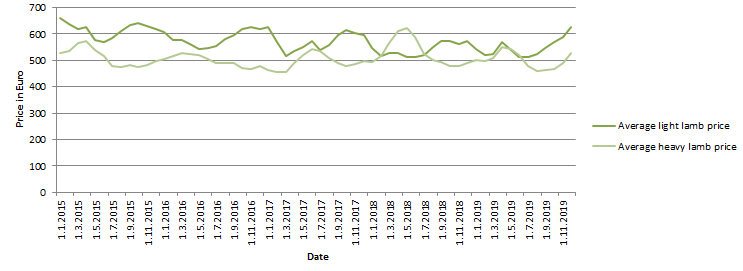Table of Contents
What is hogget? Is it cheaper and better than lamb?
Most people have heard of the term lamb and even mutton. But what is hogget? Let us define the term hogget in this post.
Hogget (or hogg in some places) is a juvenile sheep, most often defined as being over 11 months old and up to 24 (sometimes 18) months old. The term hogget is mostly unknown in the United States and is mainly used in the UK, New Zealand, and Australia. Word hogget is mostly used for meat of said sheep, for either young eve or young tup. To put it even more simply, hogget meat is what comes between lamb and mutton.
Up until today, there is still no clear difference between those three terms. There are so many definitions for when a lamb is no longer lamb but is something else. What I call a hogget is a sheep that has been weaned, sheared once, and has survived its first winter, and is between 1 and 2 years old.
If you ask any seller, he’ll try to convince you that even a 2-year-old sheep is still a lamb. Lamb is defined as premium class meat, so it’s natural that everyone is going to try to stretch out this category as long as they can. You can notice the legislation changing in this direction everywhere.
For example, there was an official change of lamb definition in Australia in 2018. Previously, a lamb became a hogget when its two incisor baby teeth were replaced with adult ones, at around 12 months after its birth. Now, for export purposes, the government has changed the law so that lamb is still a lamb until their incisor teeth start to experience noticeable wear. It gives sheep around 4 more months of being defined as a lamb. Everybody is chasing a better price at the market. New Zealand actually has the same definition as Australia regarding all this.
As I’ve written before, the term hogget is mostly unknown in the United States. Sheep products under 12 months old are defined as ‘choice lamb’ or ‘prime lamb’. Everything else can be labeled and marketed as simply lamb.
Sheep definitions from a veterinary dictionary (Miller And West)
- Birth to weaning
- Female – ewe lamb, gimmer lamb
- Male uncastrated – tup lamb, ram lamb, heeder, pur lamb
- Male castrated – hogg lamb
- Weaning to shearing
- Female – hogg, hogget, ewe hogg, gimmer hogg, ewe teg, sheeder ewe
- Male uncastrated – hogg, hogget, hoggerel, haggerel, ram hogg, tup teg, tup hogg
- Male castrated – wedder hogg, wether hogg, he teg
- First to second shearing
- Female – shearling gimmer, shearing ewe, gimmer, theave, double-toothed ewe
- Male uncastrated – shearling, shear hogg, shearing, one-shear tup, diamond ram, diamont ram tup
- Male castrated – shearing wether, wether hogg, wedder hogg, shear hogg, 2-tooth wether
Plural of word hogget
The plural form of hogget is hoggets.
Pronunciation of word hogget
hogget/ˈhɒɡɪt/ if you want to hear it pronounced correctly, please check the following YouTube video:
How much does a hogget cost? Is hogget cheaper than lamb?
Because hogget meat is less sought after than lamb and doesn’t sound so nice either, it can usually be much cheaper. I haven’t found a good analysis of hogget meat prices, but that’s most likely because the term hogget is mostly used in a farming environment, not so much in markets and retail. But, I managed to find average EU prices for light and heavy lamb. The heavier the animal, the lower the selling price.
Average lamb carcass weight (deadweight) prices per 100kg in EU:

Source: ahdb.org.uk
How much does a hogget weigh?
How much does a hogget weigh when farmers sell it? The most popular liveweight (don’t confuse with deadweight) range is 38-47kg. Of course, everyone wants to get a better price, so there is a little bit of calculation always involved. Farmers have to consider the weight that hogget is going to gain if they sell them later, lower prices of their meat as they gain that weight, and of course the cost of supplementary feeding if they are using it.
What does hogget taste like?
“Hogget is simply lamb with wanderlust and a decent education. It’s killed when it’s between twelve and eighteen months old, so it knows a thing or two about flavour. It doesn’t overwhelm like old mutton, yet still bleats with ovine delight.”
-Tom Parker Bowles, Let’s Eat Meat
In contrast to lamb, a hogget has had a chance to grow a little bit. It has a bigger, but slightly leaner carcass because it has survived one winter and thus melted some of its fat reserves. If raised properly, the hogget has grazed fresh spring grass and for that reason, its meat will be richer in flavor. It won’t be gamey as mutton, but it will be slightly stronger than lamb. Some people don’t like that fatty residue that lamb meat leaves on their lips, so for them, the hogget might be the right solution. I’d suggest cooking hogget in the same way that you’d prepare a lamb. Its taste won’t disappoint you.
Most professional chefs would suggest to prepare a hogget hot and quick, just like a lamb, or to prepare it low and slow. Just don’t do something in between because that might toughen it up. If a professional chef would describe it, they would say that hogget is a very versatile meat that has a very nice fat to meat ratio.
For a perfect taste and the best quality, I’d suggest only grass and hay fed lambs and hoggets. One additional tip for farmers would be to shear them before winter and in that way encourage them to eat more to stay warm. Of course, that might not apply to all climates.

How to prepare hogget
Difference between lamb, hogget, mutton: an easy rule is the darker the color of the meat, the older the animal will be.
Hogget, as mentioned before, has an incredible depth of flavor. It’s just perfectly suited to being roasted. Part-boned and rolled leg of hogget or hogget shoulder are great for this. Before you begin, leave the joint at room temperature for 1 hour. A great tip for a perfect roast is to preheat the oven to 220C/200C+fan/gas7. Don’t forget to create multiple incisions in the joint, rub oil, and season generously. Leave in the oven for 10min, then lower the temperature to 180C/160C+fan/gas4 and then calculate the cooking time. My suggestion would be:
- Rare: 15min per 450g of hogget
- Medium rare: 20min per 450g of hogget
- Well-done: 25min per 450g of hogget
After taking the roasted leg or shoulder out of the oven, wait for it to rest and cool down for at least 10-15min. Carve and serve.
I have one other hogget recipe for you. Hogget stew. You can use lamb for this, but I prefer hogget for a little bit more flavor. Use Crock Pot for this recipe. Preheat the water and stock in the pot. On a side, use a skillet and stir and brown some chopped bacon and hogget that you’ve cut into small cubes. When done, add the meat to the pot. Brown onion and garlic in the same skillet. Add them with all remaining grease to the pot as well. After that add thyme and basil to the pot and cook on low for at least 4 hours, until meat is tender. Add carrots and potatoes. Cook for another hour or two until vegetables are done but not over-cooked. Thicken the stew if needed. Add salt and pepper. Bon appetite.
For other interesting hogget recipes, I’ve gone through some creative YouTube videos and prepared a nice and tasty selection for you. Check the videos and enjoy your delicious hogget:
Hogget gog roll:
Hogget ‘Lamb’ Loin Chops with Salsa Verde:
Balsamic-glazed hogget shoulder with freekeh and grilled radicchio:
Hogget, monk’s beard, potato and anchovy:
Spit Roast Herdwick Hogget:

